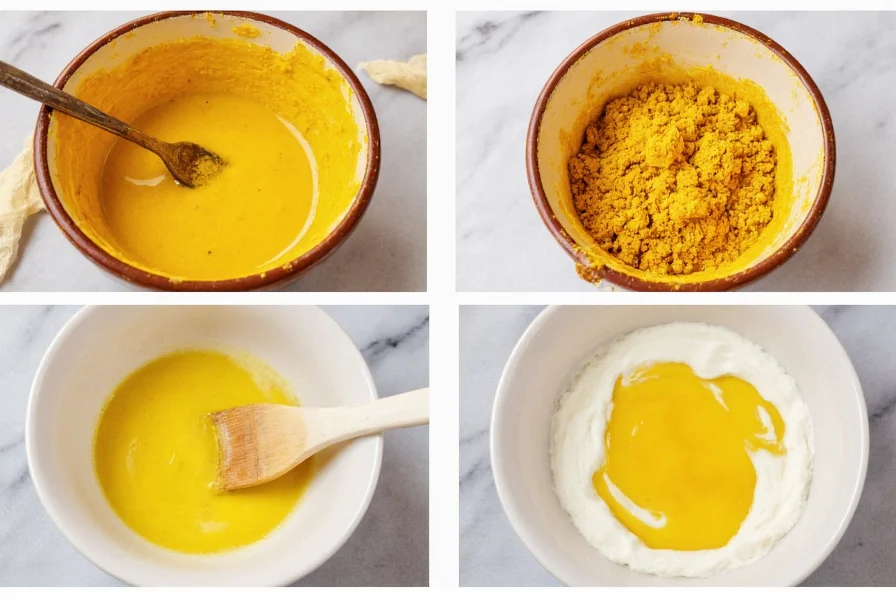Creating an effective turmeric face mask at home requires understanding both the powerful benefits and practical application techniques. Turmeric contains curcumin, a compound with proven anti-inflammatory and antioxidant properties that can visibly improve skin texture and tone when used correctly. This guide provides science-backed recipes and application methods to maximize results while minimizing common issues like staining.
Why Turmeric Works for Skin Health
Multiple clinical studies confirm turmeric's effectiveness for skin concerns. Research published in Phytotherapy Research shows curcumin reduces inflammatory markers by up to 60% in acne lesions. The Journal of Cosmetic Dermatology reports turmeric extracts improve skin brightness by inhibiting melanin production. Unlike harsh chemical treatments, turmeric face mask diy recipes work with your skin's natural processes.
Essential Ingredients for Your Turmeric Face Mask
| Ingredient | Function | Recommended Amount |
|---|---|---|
| Turmeric powder | Anti-inflammatory, brightening | 1 teaspoon |
| Raw honey | Antibacterial, moisturizing | 1 tablespoon |
| Plain yogurt | Exfoliating, soothing | 1 tablespoon |
| Lemon juice (optional) | Brightening (use sparingly) | 3-5 drops |
Step-by-Step Turmeric Face Mask Recipe
Follow these precise instructions for optimal results:
- Mix 1 teaspoon turmeric powder with 1 tablespoon raw honey in a non-metal bowl
- Add 1 tablespoon plain yogurt and stir until smooth paste forms
- Apply thin layer to clean, dry face using fingertips or brush
- Avoid eye area and hairline to prevent staining
- Leave on for 10-15 minutes (never exceed 20 minutes)
- Rinse with lukewarm water using gentle circular motions
- Follow with moisturizer to lock in benefits

Variations for Specific Skin Concerns
Tailor your turmeric face mask diy formula to address particular skin issues:
For Acne-Prone Skin
Combine turmeric with honey's natural antibacterial properties. Add 1 teaspoon of bentonite clay to absorb excess oil. This natural turmeric face mask for acne reduces breakouts without drying skin.
For Hyperpigmentation
Mix turmeric with 1 teaspoon of milk or coconut milk. The lactic acid gently exfoliates while turmeric inhibits melanin production. Use this turmeric face mask for dark spots twice weekly for visible improvement in 4-6 weeks.
For Sensitive Skin
Reduce turmeric to 1/2 teaspoon and increase yogurt to 2 tablespoons. Omit any citrus ingredients. This gentle turmeric face mask recipe soothes redness without irritation.
Avoiding the Yellow Stain Problem
Many beginners ask does turmeric face mask stain skin. Temporary yellow tint can occur but is preventable:
- Always use minimal amounts - never more than 1 teaspoon per application
- Rinse thoroughly with warm water and mild cleanser
- Apply coconut oil before rinsing to help lift color
- Wear an old t-shirt during application
- Store masks in glass containers (plastic absorbs color)
How Often to Use Your Turmeric Mask
The ideal frequency depends on your skin type:
- Oily/acne-prone: 2-3 times weekly
- Normal/combination: 1-2 times weekly
- Dry/sensitive: Once every 10-14 days
Overuse can cause dryness. Notice improved skin texture within 2-3 weeks of consistent use. This best turmeric face mask recipe for glowing skin delivers cumulative benefits with regular application.
Storage and Freshness Guidelines
Homemade masks lack preservatives, so follow these storage tips:
- Prepare single-use portions when possible
- Store in airtight glass container in refrigerator
- Discard after 3 days (bacteria grows rapidly in organic mixtures)
- Never add water to extend shelf life

Common Mistakes to Avoid
Even with the best turmeric face mask ingredients, these errors reduce effectiveness:
- Using expired turmeric (loses potency after 6 months)
- Mixing with metal utensils (alters chemical composition)
- Leaving on too long (causes dryness and potential staining)
- Skipping patch testing (some have turmeric allergies)
- Using on broken skin (can cause irritation)
When to Consult a Professional
While a simple DIY turmeric face mask benefits most skin types, consult a dermatologist if you experience:
- Persistent redness or burning
- Swelling or blistering
- Worsening acne after 2 weeks of use
- Known sensitivity to plants in the ginger family
Frequently Asked Questions
How long does it take to see results from a turmeric face mask?
Most users notice improved skin brightness within 2-3 applications. Significant reduction in inflammation and acne typically appears after 2-4 weeks of consistent weekly use. For hyperpigmentation, visible results usually require 6-8 weeks of regular application.
Can I use turmeric face mask overnight?
No, leaving turmeric on overnight significantly increases staining risk and may cause irritation. The maximum recommended time is 15-20 minutes. For extended treatment, apply the mask, wait 10 minutes, then rinse and follow with a turmeric-infused serum designed for longer wear.
What's the best time of day to apply a turmeric face mask?
Evening application is ideal as it allows skin to recover overnight. Turmeric can make skin slightly more photosensitive, so daytime use requires strict sunscreen application. Many users prefer weekend mornings for turmeric and honey face mask treatments to allow time for any potential staining to fade before social activities.
Can I use fresh turmeric instead of powder?
Yes, but fresh turmeric root contains more moisture and may stain more readily. Grate 1 inch of fresh turmeric root and mix with 2 tablespoons of carrier ingredients. Fresh turmeric has slightly higher curcumin content but requires more careful straining to avoid gritty texture on skin.
Why does my turmeric mask feel warm on my skin?
This mild warming sensation comes from turmeric's natural compounds interacting with skin receptors. It's normal and indicates increased circulation. However, intense burning or stinging means you should rinse immediately - this indicates potential sensitivity or too high concentration.










 浙公网安备
33010002000092号
浙公网安备
33010002000092号 浙B2-20120091-4
浙B2-20120091-4